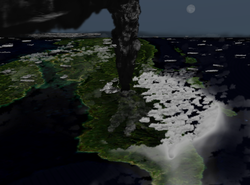From Wikipedia, the free encyclopedia
| Toba supereruption | |
|---|---|

Illustration of what the eruption might have looked like from approximately 26 miles (42 km) above Pulau Simeulue.
|
|
| Volcano | Lake Toba |
| Date | Between 69,000 and 77,000 years ago |
| Type | Ultra Plinian |
| Location | Sumatra, Indonesia 2.6845°N 98.8756°ECoordinates: 2.6845°N 98.8756°E |
| VEI | 8.3 |
| Impact | Most recent supereruption; plunged Earth into 6 years of volcanic winter, possibly causing a bottleneck in human evolution and significant changes to regional topography.[1][dated info] |
 |
|
| Lake Toba is the resulting crater lake | |
The Toba event [3][4] is the most closely studied super-eruption.[5] In 1993, science journalist Ann Gibbons suggested a link between the eruption and a bottleneck in human evolution, and Michael R. Rampino of New York University and Stephen Self of the University of Hawaii at Manoa gave support to the idea. In 1998, the bottleneck theory was further developed by Stanley H. Ambrose of the University of Illinois at Urbana-Champaign. Other researchers have questioned or found no evidence for a link between the Toba eruption and such a bottleneck.

No comments:
Post a Comment